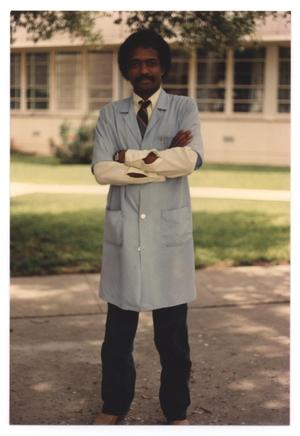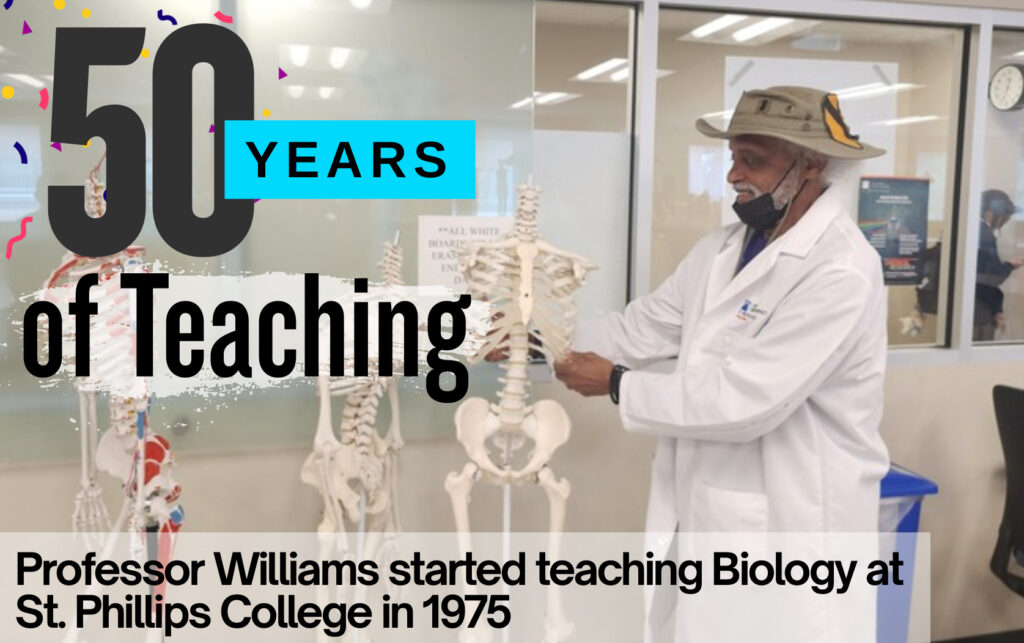Honoring Professor Al Williams: 50 Years of Teaching, Mentorship, and Legacy at St. Philip’s College
(Article by Scott L. Earle, Sr.) — “Give people their flowers” is an expression that encourages honoring and recognizing people while they are still alive, rather than waiting until after they are gone. This spotlight on Professor Al Williams is well deserved, and the authors attend to give this local icon his flowers.
A Half-Century of Service in Education
Professor Williams started teaching Biology at St. Philip’s College in 1975. St. Philip’s College is a public historically Black community college (HBCU) in San Antonio, Texas. Professor Williams walks around campus with his trademark straw hat, overalls, and ever-present smile. A student will walk into his class and see him wearing his lab coat, and from the minute he opens up, his passion for knowledge is easy to spot.
This year, Professor Williams started his 50th year on campus, and from watching him engage with students and faculty, I do not see him slowing down anytime soon. At a time where younger aged Americans 20-24 average around 1.4 years of tenure, while those aged 25-34 average 2.7 years, middle-aged Americans aged 45-54 average 7.0 years, and those aged 55-64 average 9.6 years- and Americans aged 65 and older have an average tenure of 9.8 years; Professor Williams beats all those statistics.
Humble Roots in Seguin, Texas
Professor Williams is a native of Seguin, Texas, which is thirty-six miles from San Antonio. He is the middle child of the late Dr. Mason L. Williams, MD, and the late Arlene Mack Williams. Throughout our conversation, he gives credit to his success in life to the “village environment in which he was raised.” His relatives, neighbors, teachers, and coaches, whose love and stern mindfulness ensured he always respected his family name.
A strong Christian upbringing and a caring, segregated community gave him the guidance he needed to succeed. Attending the segregated Seguin ISD public schools, he excelled in the classroom and sports. He graduated from Ball Lincoln High School as a class Salutatorian and started as a halfback on the football field. His head football coach, William “Goldie” Harris, and assistant coach Clarence “Heavy” Little were mentors whom he respected.
From Prairie View A&M to the U.S. Army
Upon graduation, he had the choices of Wiley College, Prairie View A&M, Huston Tilliston, and Texas Southern as schools that most of his peers chose. He chose Prairie View A&M and remarked their colors matched his HS colors and the fraternity colors he would join. When he arrived at Prairie View, fraternity and sorority life were not allowed.
He poured himself into his chosen major of Biology and Army R.O.T.C. He graduated as a Beta Beta Beta Biological Student and an ROTC Honor Student. He was commissioned as an Army Second Lieutenant and completed his M.S. in Biology as a Graduate Assistant.
He served our country for four years as a U.S. Army Officer – Field Artillery 1st Calvary Division – Vietnam War Era at Ft Hood (Fort Cavazos) and Ft Sill. Once he served our country and returned to Seguin, he was called in the summer of 1975 and asked if he was interested in teaching a summer Biology course, and he never left.
Lifelong Commitment to St. Philip’s College
As a young professor, he was mentored and led by the late Dr. T.R. Williams and the late Dr. Lanier Byrd. Both men left a significant impact on the young professor. While at St. Philip’s, the influence mentors continued.
Associate Dean Leonidas Watson ran the night division for St Philip’s, and his leadership influenced him; the Watson Fine Art Center bears his name. Another influence was Coach William Allen Hudgins, who was a coach and Dean of Student Affairs, and was well respected on campus, and retired after 37 years, and whose name is on the Health and Wellness Building.
Mentors Who Shaped His Legacy
In addition to these two men, Dr. William C. Davis, a world-renowned chemist, and mentor to the Professor. When the Professor took us to Dr. Davis’s office, which the college has kept in tack, he had so much pride. Dr Davis created instant mashed potatoes, soft-serve ice cream, and industrial glue. He standardized medical tests for insulin and growth hormones. Working with a St. Philip’s College colleague, the late Vice President of Academic Affairs, Dr. Lanier Byrd, Dr. Davis studied the characteristics of drinking water and co-created the formula for Dasani brand water.
He was named professor emeritus upon his retirement in 2009. In 2012, the college science building was named in his honor, the William C. Davis Science Building.
A Teaching Style Students Remember
While reading reviews on the professor, I noticed that the common detail was the importance of spelling. Although he teaches Biology, he shows the students the importance of the correct spelling of the many terms they must learn. The students we interviewed appreciated his “old-school” method, which is important in any decade.
A Lasting Impact Beyond the Classroom
I told the Professor at the end of the interview that even wearing purple and gold in any hospital or clinic in San Antonio, you will be stopped by a nurse who says they learned from Professor Williams.
Many of us do not give our elders flowers, but I hope the two hours on campus, coupled with our many talks that assisted with this piece, are the flowers I can give to Brother Professor Al!











